According to M.L.B. Round-Table, Harrold, Tom, Bob, Al, and Michael Young have decided that Major-League hitters are experiencing a horrific decline in batting proficiency, and batting averages, slugging percentages, and run production, and prolific strike-outs are the evidence of this profuse deficiency. These astute analysts are at a loss however for the cause of and the solution to the dilemma.
Many speculative theories were brought to the table, but none were convincing enough to attach any credibility to the apparent conundrum. Lowering the pitching mound, or giving the batter 4 strikes, or allowing a particularly good hitter to bat out of turn in the late innings to allow his team a better chance to score base-runners that would not likely be driven in by a lesser hitter, are not practical alternatives to naturally improving the offensive capabilities of all players on the team.
Basically, all Major-League batters are “good-hitters,” but simply not consistent. On any given day, they look like potential “H.O.Famers.”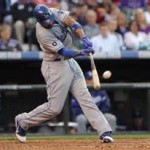 But more often they do not!
But more often they do not!
It would be better for hitters if they had only 2 strikes, rather than 3 or 4. 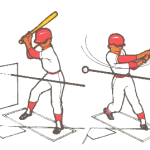 Too many hitters watch a first pitch fast-ball (the only pitch in a sequence they could have hit) be called for a strike, and then swing at balls in the dirt to strike out, after fouling off a few.
Too many hitters watch a first pitch fast-ball (the only pitch in a sequence they could have hit) be called for a strike, and then swing at balls in the dirt to strike out, after fouling off a few.
Why give them 4 strikes? So they can take the first 2 pitches? And make a game last even longer? Rather than let any good hitter bat out of turn, it would be more reasonable to add a rule to allow a second Designated Hitter (once both Leagues have the standard D.H.) to bat for anyone (a “regular”), in the 7th, 8th, or 9th innings (and rest of the game), who may be having an unusually “bad day” at the plate. (Matt Stairs might have enjoyed longer career.) All this is predicated, of course, on Pitchers not objecting to the additional burden placed on them.
It’s only a matter of time before the “dinosaurs” of the past glory will be replaced by the initiators of present and future ingenuity. The “Designated Hitter” was only the first in a series of innovative consequences to creative thinking that has heightened the prospect of enhancing the flavor of the game. Inter-league action, and Three-Division Play have subsequently stimulated increased fan-interest (and record-breaking attendance), and the ultimately exciting Pennant Races.
Baseball’s intelligentsia could do a better job with regard to rule changes that would not only improve the game’s image, but also increase the fans appreciation for its innately concise and productive allurement. Past attempts to pick up the Game’s pace have failed in a substantive way. Fans want action, not just a means to hurry-up the game.
The “Big-Whigs” are missing the point by forcing the batters and pitchers to hurry-up, and allowing less prep-time. Also, enforcing the “high-strike,” to force batters to pop-up or strike-out, is not what the fans want to see. Let’s speed up the game in areas that have real downtime. Intentional walks, hit-bats-men, and pitchers working the batter carefully to the “full-count” are three areas that defeat the whole premise of fan-appreciation, and add to a batter’s inefficiency.
Nothing is more boring, especially to the fan, than watching a pitcher intentionally walk a batter on straight pitches. Not only that, but imagine how a fan feels, after having paid 30 Bucks (or more)to see Mark McGwire, Barry Bonds, Ted Williams, Babe Ruth, etc, etc, and a pitcher intentionally walks them every time up. What a waste of money, as well as time, energy, and talent! The “old guard” calls it strategy. It’s like the “Stall” that intelligent people of Basketball got rid of long ago.
The Intentional Walk has no place in modern Baseball! Just think about future Home run records if players like Barry Bonds had an extra 200 at-bats with which to work? How do you legitimately stop the Intentional Pass? Any player who is walked on four straight pitches should be granted two free bases, not one! Give the fans something more to cheer about, not Booo about! Then watch the increase in “Run Production.”
The “left” hand of the unacceptable intentional walk is the ever-repulsive hitting of the batter, by a pitch thrown at the speed of 90 to 100 MPH! Many times, it could be a few minutes before the game is resumed, after the injured player is either deemed able to continue, or is taken out of the game. Some times, fights break out and it might take a lengthy time to restore order and resume the game, under a hostile atmosphere, not conducive to good sportsmanship!
If the umpire detects such a pitch to have hit a batter “squarely” with a “fastball” (instead of just a graze or a breaking pitch), the batter should be given two bases! Just think about how fan-friendly those two rules would affect the game, as well as bring out the best of the players. Batters can substantially reduce the “intimidation factor” that every hard-throwing pitcher has had in his arsenal, and the psyche of every batter will be restored to facilitate better hitting prowess.
With regards to forcing the batters to swing more, what would be wrong with changing the strike-ball ratio to two strikes you’re out, and three balls you walk? Now, so many batters take the first strike. Then, they’d be more inclined to swing at the first strike they see (like in batting practice). This way there would be fewer pitches thrown in a game. Games would go faster, but with minimum down time (more action), and pitchers might be able to better preserve their arms. This could have the effect of improving defensive readiness; thus the potential for outstanding plays by ever-alert fielders is considerable. (It is most unlikely that strike-outs will occur as readily as might be expected because batters will no doubt foul pitches off.) And batters would be more ready to swing and hit the pitched ball.
All it takes is a little ingenuity to reinstate the Game of Baseball to its former status of untainted Glory (as we kids played it). These rules will help:
- Constructively speed up the pace.
- Two strikes, and you’re out.
- Three balls, and you walk to first, unless consecutively, then to second base.
- A squarely hit bats-man with a “fastball” receives two bases.
- Make the D.H. universally accepted in both leagues (who wants to see the pitcher bat—nowadays, he can’t even bunt properly, and he could hurt himself – e.g. Kevin Brown, A.J. Burnett, and countless others.
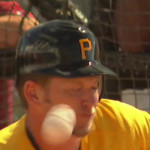
 (And perhaps a second D.H. in late innings.)
(And perhaps a second D.H. in late innings.)
If our “slow-to-respond-to-change” Baseball Purists feel that these antics are still too premature to consider as respectable alternatives for improving M.L.B.’ current lack of offensive productivity, then perhaps the practical application of scientific reasoning to improve the aptitude of many of our current crop of hitters should be given utmost consideration. this could reduce the batting deficiency-quotient now presenting itself to Major-League Baseball and its Billions of fans.
In all of my essays, the standard principle I employ to improve the batting proficiency of those players struggling in the doldrums of slumps or general inefficiency is to “reduce the margins for error”. A “margin for error” would simply be any physical or mental habit that, in some seemingly innocuous way, would detract or distract a batter from thinking or acting in a manner that would normally allow a natural flow of mechanical efficiency in swinging a bat to make solid contact with a pitched ball.
The five most obvious (ostentatious) deterrents to efficient bats-man-ship are:
- A High Stance (especially when “opened”)
- High Hands and Bat
- The Stride (or leg-kick)
- Hands holding bat below the bat-handle-knob
- Intimidation of Hard-Throwing Pitcher
As most ardent sports enthusiasts already know “hitting a baseball effectively is the single-most difficult act to perform in all of Sports.” Why? No other individual sport-skill encompasses the variety of challenging variables that a batter has to “put in order” to be a proficient “hitter.” Along with physical attributes of strength, flexibility, quickness, balance, and coordination, as well as the mental accoutrements of courage, confidence, determination, and fortitude, the proficient bats-man must ascribe to a technique of proper mechanics that facilitates the most probable means for making solid contact with a pitched baseball in what is considered an acceptable proportion of his “at-bats.”
In professional baseball, batting averages ranging from .300 to .399 are considered high quality hitting, with an annotation of “superlative” attached to those that exceed the .350 mark or flaunt with the barrier of .400. But most ball-players fall far short of consistent .300 – hitting prowess. Natural athletic ability does not seem preponderant in determining batting proficiency at the highest level. All batters seem to have their own individualistic style for expressing their highest hopes of masterful bats-man-ship.
There does not seem to be a standard approach (“techne”) that would be considered fundamental to the purpose of maximum efficiency in hitting a baseball. Some players stand tall; others crouch low. Some hold their hands and bat high, while others hold them low. Players address the “plate” in either an open, closed, or even stance.
Most batters take a stride, either away, toward the plate, or toward the ball. They tend to push off the back foot while straightening the back leg as the weight is either trying to stay back or lunge forward. Some hitters think that maintaining even shoulders while swinging will facilitate a “level swing” for effective line-drive contact. Others perceive that by swinging downward onto the front part of the ball, the bat will effect a “back-spin” on the ball that will allow it to carry through the air longer and farther. Some batters cock their wrists back for extra power, and consider themselves “wrist-hitters” when they exhibit fast hands while rolling the bat through the ball quickly.
Some batters maintain loose hands and wrists while they are swinging so that relaxed muscles will propel the bat more quickly through the strike zone. And still others (like Babe Ruth) squeeze the bat tightly, from start to finish, and rely on the speed and strength of the turning body to impact the bat onto the ball with a force to counteract the speed and power of the pitch. And some batters place the bottom hand below the handle of the bat while others “choke-up” on the bat at various levels.
From the contents of the preceding paragraph, is it possible to delineate the characteristics that might lead to the creation of what could be considered the quintessential professional bats-man? The answer is NO! Ten pronounced characteristics mentioned in the foregoing illustration enumerate the “margins of error” that exacerbate the promising intentions of all prominent prospects for batting excellence:
- A “Tall” stance creates a large and easy strike zone for the pitcher, as well as proposes a line of vision for the batter’s eyes that transcends countless horizontal planes in following the flight of the ball to the plate.
 The eyes that will see the pitched ball most clearly are those that come as closely as possible to the level of the ball in flight. Also, the taller the stance, the higher the center-of-gravity, the weaker and slower the body’s action, the lesser the prospect for a most effective swing, especially at a low pitch.
The eyes that will see the pitched ball most clearly are those that come as closely as possible to the level of the ball in flight. Also, the taller the stance, the higher the center-of-gravity, the weaker and slower the body’s action, the lesser the prospect for a most effective swing, especially at a low pitch. - When the batter’s hands and bat are held above the shoulders and head, he unwittingly has created for himself a higher center-of-gravity, which for all practical purposes diminishes the leverage by which the maximum speed of the body can be facilitated in turning the hips and shoulders
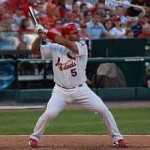 .
. - A low stance, with bat and hands held
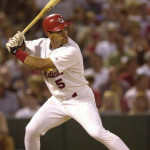 simply at the level of highest strike, facilitates the fastest body action and appropriates the greater chance of getting slightly under and behind a low pitch. If Matt Kemp would simply lower his hands and bat, his swing would be considerably more “level” rather than “horse-shoe” in nature.
simply at the level of highest strike, facilitates the fastest body action and appropriates the greater chance of getting slightly under and behind a low pitch. If Matt Kemp would simply lower his hands and bat, his swing would be considerably more “level” rather than “horse-shoe” in nature. 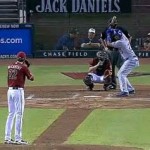 His and Pujols’ bodies are in perfect, low stances.
His and Pujols’ bodies are in perfect, low stances. - Of the three stances, the open-stance is the most deleterious to proficient batting because it tends to force the batter to stride toward the plate and therefore makes him vulnerable to hard inside pitches when he is looking outside. Then, when he hesitates while looking inside, off-speed pitches away make him off-balanced. (Chris Davis of the Orioles is finding it difficult this season- standing tall, open, and striding.) Because the stride itself is moving the body, along with head and eyes, the movement toward the plate compounds the distortion aspect of the moving pitch.
- Any stride at all is a major contributor to batting dysfunction. It is useless expenditure of energy whose purported function of initiating momentum is overrated. It becomes counterproductive to optimal visual acuity, as the head and eyes move also. If the hips move forward with the stride, the integrity of the swing itself is compromised by the dislocation of the body’s “vertical axis.” Maximum power is impossible to generate while the vertical axis is not constant.
- Pushing off the back foot while striding gives the false impression of producing power to initiate the turn of the hips during the swing. In fact, the push-off impels the back leg to continue to straighten, the effect from which restricts the turning of the hips to their maximum. The optimum hip and shoulder actions occur only when the back bent knee maintains its same bent position as it rotates through the entire hip rotation. (ala Barry Bonds)
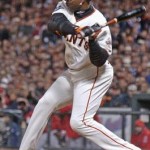
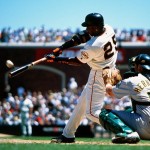
- The stride and the push-off may force the body to “lunge forward” to try to counteract the “magnetic pull” of the in-coming fastball.
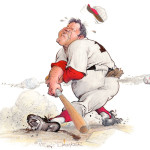 However, off-speed pitches will force the batter to hesitate by gliding forward on a bent front knee, affording no balance, nor power to swing because of the disintegration of the vertical axis, and premature turning of the hips. The hips should always be ready to turn quickly in a “turnstile” fashion, both sides in opposite directions, on the same horizontal plane, with the vertical axis intact.
However, off-speed pitches will force the batter to hesitate by gliding forward on a bent front knee, affording no balance, nor power to swing because of the disintegration of the vertical axis, and premature turning of the hips. The hips should always be ready to turn quickly in a “turnstile” fashion, both sides in opposite directions, on the same horizontal plane, with the vertical axis intact. - Parallel shoulders, while striving for a level swing, is a misconception of the ideal of good intent. If the shoulders stay level throughout the swing, at the presumed contact point the top hand will be forced to roll over the ball because the hips and shoulders have reached the limits for forward movement, and the arms will extend to keep the momentum. However, if the front shoulder is in a “shrugged” up-position, and the back shoulder lowered with a driving back elbow, the bat and ball will meet as the palm of the top-hand is facing upward. The horizontal rotation of the hips and bent back knee preclude any possibility of an upper-cut swing, as long as the front upper arm is in contact with the chest.
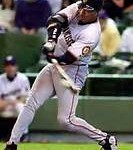
- Swinging downward onto a downward moving pitched-ball is more often counterproductive to efficient bats-man-ship than it is productive.
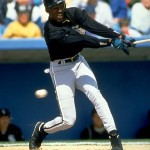 The pitcher is on a mound almost a foot above the plane that the batter is on. Every pitch is moving downward into the strike zone. If a batter with good eyesight and good coordination strikes downward onto the pitched ball, his athletic ability will probably enact solid contact a high percentage of times. Solid contact in those instances will result in balls hit on the ground. (Albert Pujols and Gary Sheffield are examples of such a hitter.) The “best of hitters” is not merely one who makes solid contact with the ball. But rather, he is a batter whose body mechanics facilitate the action of the swinging bat to contact and continue through the ball at an angle that provides for a straight (non-hooking or slicing) and ascending “line-drive.” The “Art” of hitting a baseball could certainly be defined in the context of describing the ideal hitter– “He is one whose bat most consistently contacts and drives through the ball in a manner that facilitates a straight and ascending “line-drive.”
The pitcher is on a mound almost a foot above the plane that the batter is on. Every pitch is moving downward into the strike zone. If a batter with good eyesight and good coordination strikes downward onto the pitched ball, his athletic ability will probably enact solid contact a high percentage of times. Solid contact in those instances will result in balls hit on the ground. (Albert Pujols and Gary Sheffield are examples of such a hitter.) The “best of hitters” is not merely one who makes solid contact with the ball. But rather, he is a batter whose body mechanics facilitate the action of the swinging bat to contact and continue through the ball at an angle that provides for a straight (non-hooking or slicing) and ascending “line-drive.” The “Art” of hitting a baseball could certainly be defined in the context of describing the ideal hitter– “He is one whose bat most consistently contacts and drives through the ball in a manner that facilitates a straight and ascending “line-drive.” 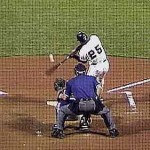 (To hit the ball in any other manner would be to miss-hit it.)
(To hit the ball in any other manner would be to miss-hit it.) - “Cocked-wrists” may deceive the batter into thinking he will have a stronger swing because of the extra action he expects to have at the “contact–point.” The extra action is counterproductive because the timing mechanism to produce a synergistic display is unreliable at best. Also, neither “cocked forward” nor “cocked backward” is the strongest position for the wrists to be in. Straight and stiff is the strong position of hands and wrists for swinging a bat, as it is for a Karate punch. What would happen if you punched a “bag” with wrist and hand cocked in either the forward of backward position? Right! Remember, the power of the swing comes from the body. But if the hands are not in their strongest position on the bat at contact, the ball will impact the bat more effectively than the bat will impact the ball; and the pitcher will win that battle.
- Relaxed hands to begin and tight hands to finish through the “contact point” is a good rule to follow. With continued “loose-hands” through the “contact,” the ball controls the bat. But if a tight grip occurs at “contact,” the ball will sound and feel like a golf- ball. The bat should be gripped with the strongest part of the hand, not in the fingers.
- The two greatest hitters in Baseball history never held their hands over the bat handle’s knob.
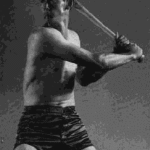
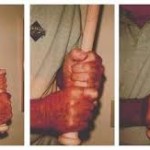

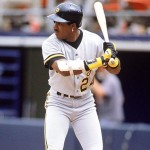 But all current “wanna-be” power-hitters think that they get better leverage to hit the ball better and farther by draping their last fingers over the knob.
But all current “wanna-be” power-hitters think that they get better leverage to hit the ball better and farther by draping their last fingers over the knob. 
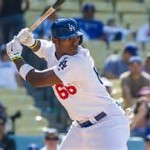 Baseball is a game of “inches,” in general. But with regard to hitting a baseball, “micro-measures” would determine the microscopic “margins for error” that distinguish the elite hitter from the ordinary. The unscientific hitter doesn’t realize that the extra weight at the upper end of his bat, as he is swinging (especially at an outside pitch), is the very reason he consistently fouls “his-pitch” straight back or to the “off-side” when he could have hit it squarely had his hands been slightly up on the bat handle. How often does a “good-swing” go for naught as the “bat-head” is simply too far under the ball as the bat is angled too sharply toward the ground. A higher percentage of solid contact will occur when the bat is more parallel to the ground
Baseball is a game of “inches,” in general. But with regard to hitting a baseball, “micro-measures” would determine the microscopic “margins for error” that distinguish the elite hitter from the ordinary. The unscientific hitter doesn’t realize that the extra weight at the upper end of his bat, as he is swinging (especially at an outside pitch), is the very reason he consistently fouls “his-pitch” straight back or to the “off-side” when he could have hit it squarely had his hands been slightly up on the bat handle. How often does a “good-swing” go for naught as the “bat-head” is simply too far under the ball as the bat is angled too sharply toward the ground. A higher percentage of solid contact will occur when the bat is more parallel to the ground 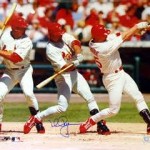
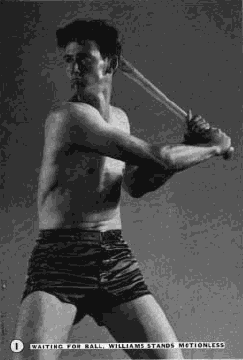 than when it is more perpendicular.
than when it is more perpendicular. 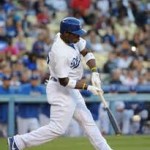 (A batter in a high stance is more apt to swing at low pitches with an exaggerated “perpendicular” slant to his swing while the bat of a batter in a crouch will be more “parallel” to the ground)
(A batter in a high stance is more apt to swing at low pitches with an exaggerated “perpendicular” slant to his swing while the bat of a batter in a crouch will be more “parallel” to the ground)
The “Premier Batting Principle” is based on the perfect application and integration of following components:
1. Balance and stability of the stance.
2. Security for undisturbed visual acuity.
3. Self-contained power source.
4. Balance and stability from start to finish of swing.
A low center of gravity can be established by spreading the feet to the width of one’s normal stride, and bending the knees as low as can accommodate comfort and quickness. This strong base affords the batter the fastest possible reaction time for a twisting body to respond to any variation of pitched balls. One of the most prominent features of a low stance is the obvious advantage the batter has with the establishment of a smaller strike zone.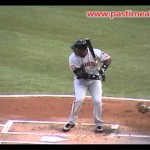
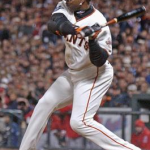
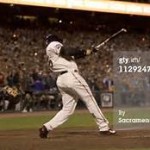
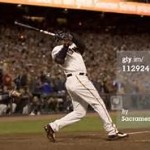
With the low-wide stance, the batter is in an “ultra-stationary” position, from which to view the pitched ball with a minimum of distortion. 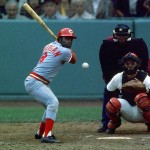 As a tennis player, receiving serve, is bent over and down as low as he can, to see the speeding ball on as close to a parallel level to the eyes as possible, so the batter, in a low stance, views the pitched ball with most clarity.
As a tennis player, receiving serve, is bent over and down as low as he can, to see the speeding ball on as close to a parallel level to the eyes as possible, so the batter, in a low stance, views the pitched ball with most clarity.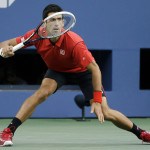
With the body already in a stable and powerful position, from which to initiate the action of the swing, the only preliminary movement needed by the batter, as the pitcher is delivering the ball, is to brace himself (or “gather”). From there he awaits the arrival of the ball into the striking “zone.” The gathering simply implies that the body is twisting or coiling slightly in the direction toward the catcher, bringing the hands to a position just beyond the back shoulder, making ready to spring forward as the ball comes to the plate. The “coiling” is initiated by the front knee turning inwardly off a pivoting big toe. 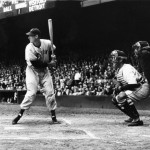 While the back foot is anchored flat, the weight of the body is centered from the upper abdomen to the ground directly between both bent knees. The hips and shoulders follow the backward rotation of the twisting torso (the body never leaning backward with any concentration of weight on the back leg – the “buttocks” looks to be sitting on a high stool). The entire action of the backward twisting and subsequent forward explosion in the opposite direction, as the swing takes place, occurs while the head remains stationary and the eyes still, focusing on the ball.
While the back foot is anchored flat, the weight of the body is centered from the upper abdomen to the ground directly between both bent knees. The hips and shoulders follow the backward rotation of the twisting torso (the body never leaning backward with any concentration of weight on the back leg – the “buttocks” looks to be sitting on a high stool). The entire action of the backward twisting and subsequent forward explosion in the opposite direction, as the swing takes place, occurs while the head remains stationary and the eyes still, focusing on the ball.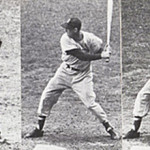
After the swing has been completed, every part of the body will have rotated around and under the “fixed” head. 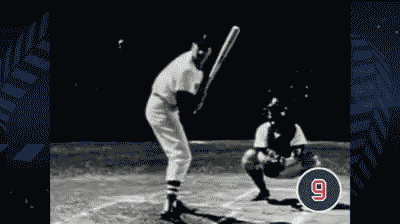
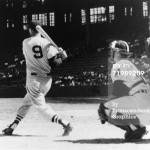 The height level of the batter at the end of the swing should be the same as it was at the beginning. Stability and balance at the end is as important as at the beginning. This order procures maximum efficiency for the sensitive guidance system which the eyes and head provide to the forces of the body.
The height level of the batter at the end of the swing should be the same as it was at the beginning. Stability and balance at the end is as important as at the beginning. This order procures maximum efficiency for the sensitive guidance system which the eyes and head provide to the forces of the body.
Coming Soon: There are No Bad – Hitters in Major-League Baseball!